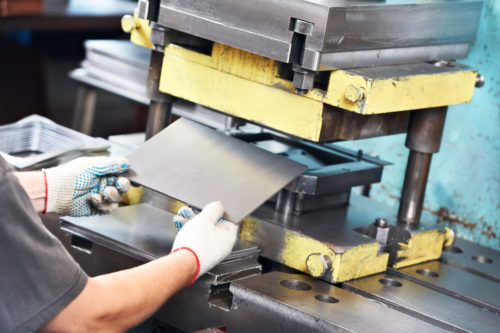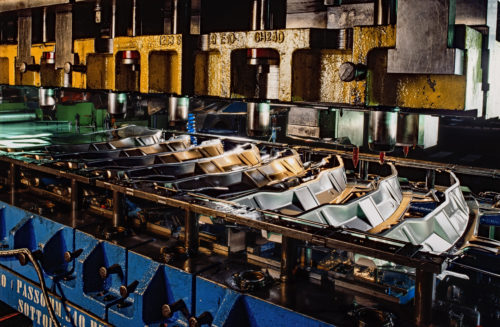Metal Stamping Custom Components
Leave a CommentWhen you partner with an experienced, industry-leading parts manufacturer, you’ll gain access to a wealth of standard tooling options from which to choose. Occasionally, however, standard offerings may not be enough. If you are considering one or more custom components, it is helpful to understand when you should seek custom manufacturing as opposed to standard, and what to keep in mind to make the most beneficial selection.
Custom vs. Standard Deep Drawn Manufacturing
Most projects can be accomplished with standard deep drawing dies, even if they include complex geometries. But when you use standard components instead of designing new components from scratch, your options will necessarily be limited and might not suit your needs. If you want an angle, depth, or shape that is uncommon, for example, you might need to engineer and commission prototypes to build a part that’s fully customized.
However, this process is expensive and takes more time than using standard parts. To reap the benefits of both custom and standard solutions, look for a manufacturer who can modify existing components to fit your specifications. This process is called a “custom-standard” solution, and if these changes are minor, it will usually be faster and more affordable than developing a new component from scratch. Cans, cases, enclosures, covers, and headers are all relatively easy to modify with deep draw manufacturing. For example, if you have a standard can with a welded or brazed bracket, a manufacturer can replace the can with a custom version that has a drawn flange. In this scenario, the manufacturer will have provided a custom-standard solution that’s more effective than the standard option but faster and less expensive than building the part from scratch.
Common Deep Drawn Modifications
Many changes can be incorporated into standard deep-drawn components. For example, beads, ribs, holes, inserts, notches, slots, trimming, embossing, dimpling, and marks can all be added during the deep draw tooling process to create a near-custom component. Brackets can also be attached, and paint, powder coating, silk-screened graphics, and various plating types are available as well. These secondary standard modifications, when integrated into the deep draw manufacturing process, can reduce the production length and cost, as well as improve the product’s overall quality.
Benefits of Custom Finishes
Custom finishes can be applied at the end of the deep draw metal stampings process. Many options provide unique capabilities or attributes for specific applications. Operations like marking, for example, adds identifying numbers, letters, or graphics to a part. Embossing engraves shallow characters into the metal or raises the surface to create punctuated characters. Notches and threading are two processes that facilitate an appropriate fit.
Further efficiencies can often be gained by having a custom deep-drawn part delivered that’s already prefinished with paint or a chemical film to provide corrosion-resistance (a process called passivation). Electro-polishing, plating, brazing, laser drilling, and laser etching are all finishing services that alter the material’s surface and can serve a practical or aesthetic purpose.
What Is “Part Complete?”
If a system is part complete, it means all the necessary operations are performed in one process. This approach provides many advantages over traditional, multi-level assembly; in general, it offers better accuracy, efficiency, and turnaround time, as long as all the technical requirements can still be met.
If you need to execute secondary operations after receiving a part, talk with a manufacturer to determine if some of these operations can be addressed during the deep draw process. By consolidating these steps, you might be able to make assembly more cost-efficient and eliminate opportunities for human error.
Click here to download our Catalog vs. Custom Deep Draw Metal Stamping eBook →
Hudson’s Standard Tooling Library
Before requesting a quote from a deep-draw manufacturer, look at their tooling library. The manufacturer should have a catalog of standard products without additional tooling charges, which will help to control your overall costs and lead time. Even if some tooling is required, a manufacturer with an extensive standard library can often use their existing components to provide a cost-effective solution.
Hudson Technologies’ standard tooling library contains over 15,000 unique components. We make it easy to find precisely what you need by allowing users to search by the part number, keyword, size, diameter, shape, application, or material. Thanks to our extensive catalog, we can modify existing components to let you decide which properties you want to have in your final component. Whether you want a nonstandard finish or an improved assembly process, Hudson Technologies can provide a standard, custom, or custom-standard solution that suits all your needs.
Click here to browse our standard catalog→
Custom Component Solutions from Hudson Technologies
Hudson Technologies is an AS9100D-certified company that has been designing and manufacturing the highest-quality metal stamping solutions since 1940. In 2007, we also converted our 115,000-square-foot facility to 100% green manufacturing. If you need to create custom components, Hudson Technologies can offer deep drawn stamping services that will improve your product quality and optimize lead time. To get started on your next custom component solution, or discuss which stamping service is right for you, contact Hudson Technologies today.







